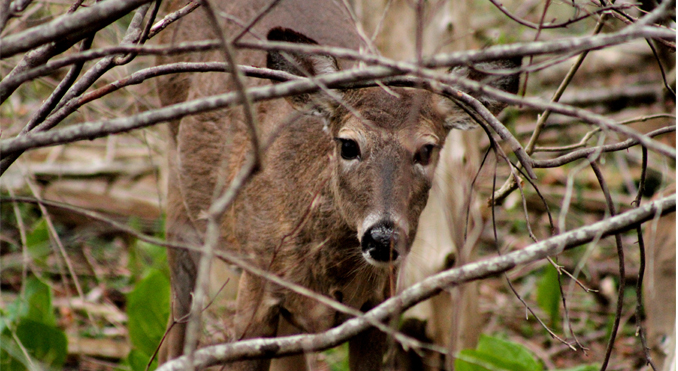

Spring has sprung folks and once this COVID-19 pandemic passes, we can get ourselves back outdoors and enjoying the more natural things in life. Meanwhile, I thought it was a good time to discuss “what to do” when you come across a wild animal that may need help.
To start, it’s best to understand that wildlife will always fair best in the wild, particularly with others like themselves, but sometimes they run into a problem which requires a little help. And that help might require a human to intervene and physically handle the scared critter, get them to a vet or a rehabilitation facility to get well, then release them back into the wild.
In a standard wildlife emergency cycle the animal is rescued, and with no injuries it is released on the spot. If there are injuries, the animal is prepared (secured) for transport, then brought to one of our local vets who have wildlife experience. We are very fortunate to have a few in our area; however, these emergencies cut into the schedules of these professionals, so it’s important that the animal’s injuries require their attention before bringing them in.
We’re also extremely fortunate to have the amazing Evelyn Alexander Wildlife Rescue & Rehab Center in Hampton Bays, which also houses the only wildlife hospital on Long Island. If an injured animal is fortunate enough to be transferred or brought to EA, chances are the animal stands a great chance of a complete recovery. Again, I mention this to point out the importance of not overwhelming the center with animals that don’t require help, or would do best if left alone, as this could take away the quality of care for other animals that DO need the center’s help, and that’s basically what this months column is all about.
Even folks who do the wildlife rescues are volunteers, so again it’s important to be certain a wildlife rescue call actually requires sending a volunteer, who in some cases might have to leave work or a job to respond. Every volunteer is a bit different with their personal rescue protocol, but the general guidelines usually apply to all. With all the above stated, here are a few tips and suggestions on “What to Do” when you come across a wild animal that seems distressed.
Just because a wild animal is displaying behavior you don’t recognize, that doesn’t always mean the animal is sick, injured or in need of human intervention. And that is the number one question we must ask ourselves when ever we come across such an animal, “Does this animal need my help?” I’ve always said that the best wildlife rescue responders are the ones who know when to leave an animal alone, equally as when to help them. Here are a a few that I’m called about the most;
1) Abandoned White-tailed fawns: If you come across a newly born fawn curled up in your yard, under your window, in your driveway or a number of other open or odd places, PLEASE do not disturb. Move only if the animal is in immediate danger of being run over or attacked by a predator. Momma deer is within visible range, and although you can’t see her, she is watching her young that she has place in that spot to remain motionless. Because the fawn has very little scent, it is less vulnerable to predators, and even more so if mom keeps her scent at a distance. Momma doe will leave her baby unattended up to 12-14 hours while she forages for food, but not too far. So, what do you do when you find a motionless fawn? I suggest you report the sighting to a rescue organization (listed below) with the address, and then leave the animal alone. What are the exceptions? If the animal is covered in flies or ants, is crying for mom with no sign of mom, a dead doe is observed nearby, tips of ears are curled (dehydrated), ticks have eyes and lips swollen, or disoriented and wandering. If you observe these signs, take a cell-photo and send / text it to your local wildlife rescue, like me at 631-377-6555.
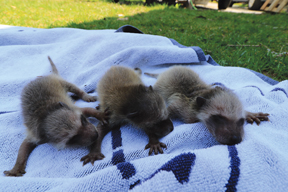 2) Baby Raccoons: LEAVE THEM ALONE. Their best chance of survival (long term) is to be raised by mom in the wild. I have watched the growth process of raccoons over and over and over again. When momma moves her young, which could be for a variety of reasons, she sometimes grabs two pups or a more mobile sibling follows. In either case, it’s not uncommon that one pup is dropped or can’t keep up and is ultimately left behind while mom finds a spot for her mouthful. SHE WILL RETURN FOR THE REST OF HER YOUNG, just give her the chance before feeling it necessary to pick them up and bring to a rehab center. These animals take a tremendous amount of time and resources to rehab, and are most often a commitment of 5 months or more before they are old enough for release. If you just don’t feel right about leaving it alone, PLEASE call a rescue or rehab center first and ask their opinion.
2) Baby Raccoons: LEAVE THEM ALONE. Their best chance of survival (long term) is to be raised by mom in the wild. I have watched the growth process of raccoons over and over and over again. When momma moves her young, which could be for a variety of reasons, she sometimes grabs two pups or a more mobile sibling follows. In either case, it’s not uncommon that one pup is dropped or can’t keep up and is ultimately left behind while mom finds a spot for her mouthful. SHE WILL RETURN FOR THE REST OF HER YOUNG, just give her the chance before feeling it necessary to pick them up and bring to a rehab center. These animals take a tremendous amount of time and resources to rehab, and are most often a commitment of 5 months or more before they are old enough for release. If you just don’t feel right about leaving it alone, PLEASE call a rescue or rehab center first and ask their opinion.
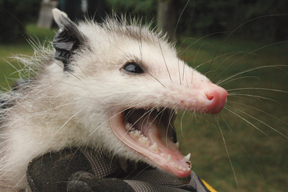 3) Opossums & Bats: Welcome them. Opossums are clean animals that have a high tolerance to diseases (particularly rabies). They don’t cause structural damage, but rather prefer a nice bed of leaves under your desk at best. Their omnivorous behavior has them eating everything from bugs and rodents, to their voracious appetite for ticks. Up to 5000 ticks per season (spring/summer 10,000 ticks per average opossum). They are also quite nonaggressive despite their devious smile, and are pretty much entirely nocturnal.
3) Opossums & Bats: Welcome them. Opossums are clean animals that have a high tolerance to diseases (particularly rabies). They don’t cause structural damage, but rather prefer a nice bed of leaves under your desk at best. Their omnivorous behavior has them eating everything from bugs and rodents, to their voracious appetite for ticks. Up to 5000 ticks per season (spring/summer 10,000 ticks per average opossum). They are also quite nonaggressive despite their devious smile, and are pretty much entirely nocturnal.
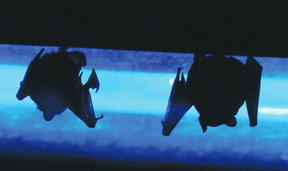 Bats on the other hand can cause damage to a home by invading attics, nesting behind facia boards and pooping on your siding. This can easily be avoided by packing the spaces under the facia’s with fine landscape netting. It’s invisible and allows any ventilation if it exists. It also keeps the bats out. Double screen your gable vents and soffit vents for even more protection from a variety of critters looking to move in. So, if they are such a problem, why keep them around? Simply because they eat insects, and lots of them. This decreases the need for pesticides. Bats are an amazing effective resource of insect control, particularly mosquitoes. They are also pollinators and distribute seeds. How do you live with the ONLY mammal that flies? Bat houses is my suggestion. I’ve been recommending them for years and have had great response. Moves their residence away from your home while keeping them close by to control your insect population. Best of both worlds.
Bats on the other hand can cause damage to a home by invading attics, nesting behind facia boards and pooping on your siding. This can easily be avoided by packing the spaces under the facia’s with fine landscape netting. It’s invisible and allows any ventilation if it exists. It also keeps the bats out. Double screen your gable vents and soffit vents for even more protection from a variety of critters looking to move in. So, if they are such a problem, why keep them around? Simply because they eat insects, and lots of them. This decreases the need for pesticides. Bats are an amazing effective resource of insect control, particularly mosquitoes. They are also pollinators and distribute seeds. How do you live with the ONLY mammal that flies? Bat houses is my suggestion. I’ve been recommending them for years and have had great response. Moves their residence away from your home while keeping them close by to control your insect population. Best of both worlds.
4) Deer with a broken leg (three legged deer): This is the hardest for most people to understand, and a difficult decision for most rescue responders. I get this call more often than most. This is how I personally handle this issue and why. First and foremost, a deer, like most animals including humans, can do just find after the loss of an appendage. There is a period of acclimation, but it’s almost always reached. The deer for one has overcome a tidal wave of burdens over the centuries from shrinking habitat, human impact, and disease and still they persevere. A simple loss of limb is not going to break these animals. Rule of thumb is, if the deer is mobile, has three working legs, doesn’t appear emaciated or is eating normally with no further serious visible injuries, then leave this deer alone. Of course observation is always welcome, and updates are appreciated by rescue and rehab facilities who are always available to give great professional and experienced advice. The alternative is to stress them with tranquilization, then transport to a vet who will in most cases put the animal down. I prefer the chance of life for these animals, as I do for any living thing with a disability, as long as suffering isn’t involved.
5) Raccoon sightings during the day (possible rabies): Please remember folks, with all the constant construction, pest control, landscaping and tree care on our small ISLAND, it’s very difficult for our wildlife to find a quiet place to rest during the day. This causes displacement of all species no matter what time of day. During the warmer months, raccoons will become more diurnal because of the vast availability of food and lack of concern of their presence. Structures become the victims during the colder months because folks vacate to winter homes in warmer climates, and the critters move right in behind them.
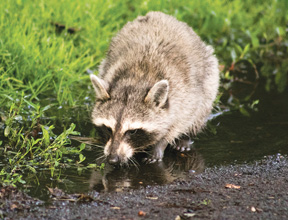 Rabies was eradicated in LI raccoons back in 2006 and has managed to stay away. Even before that, there hadn’t been a rabies case reported in Suffolk County prior. What our raccoons do get is Distemper. Canine Distemper Virus (CDV) is a viral disease that affects many animal families including rabies vector species (skunks, foxes, raccoons) and even pinnipeds (seals). It’s highly contagious and is often fatal, having no cure. There is however a vaccine which is most often given to our domestic dogs. Previously rumored not to be contagious to humans, in fact an asymptomatic infection of the CD virus can be contracted to humans, unless they were vaccinated against measles. This protects the immunized from distemper as well.
Rabies was eradicated in LI raccoons back in 2006 and has managed to stay away. Even before that, there hadn’t been a rabies case reported in Suffolk County prior. What our raccoons do get is Distemper. Canine Distemper Virus (CDV) is a viral disease that affects many animal families including rabies vector species (skunks, foxes, raccoons) and even pinnipeds (seals). It’s highly contagious and is often fatal, having no cure. There is however a vaccine which is most often given to our domestic dogs. Previously rumored not to be contagious to humans, in fact an asymptomatic infection of the CD virus can be contracted to humans, unless they were vaccinated against measles. This protects the immunized from distemper as well.
It’s best to call a rescue responder if you see a raccoon walking in circles (big or small) looking sickly, or if the raccoon seems to be losing, or lost the use of their rear legs. This, along with excessive drinking of water, are sure signs of distemper. The more severe stages are recognized by seizures that consist of teeth chattering, hand clapping (muscle spasms) and falling over. It’s very intimidating, and one should not approach an animal in such condition, however in most cases they are not aggressive nor dangerous unless they are cornered, being hurt or handled.
I hope this short list of suggestions will help you folks help us on the rescue end.
I’d also like to suggest getting a small pet carrier to keep injured songbirds overnight. Usually they come-to after a short stunned period and are able to fly away. Others pass away from their injuries quite quickly. It would help if these instances could be observed at home rather than immediately brought to the center or called for rescue. Those that get brought to the center and get well, have to be brought back to the area they were found anyway, so they can be returned to their possible families. I suggest you keep them overnight, and if they make it but still can’t walk or fly, THEN bring them to the vet or rehab center. This cuts down on their songbird ward population, and boy, do they get a lot!
We mentioned a lot of information in this column and there is still more to cover. I’ll continue next month with the conclusion. Meanwhile, it’s wonderful to care for our wildlife. They need our help and understanding. Just be certain it’s in the best interest of the animal if you commit to physically helping it. If you’re not sure, ask the experts. We have many right here on the east end, and every one of them would be happy to offer their help, advice, guidance, or opinion. Your resources are many, because WILDLIFE MATTERS.
~ Dell Cullum
Wildlife Rescue of East Hampton (WROEH.org) 844-SAV-WILD (844) 728-9453
Hampton Wildlife Removal 631-377-6555
Evelyn Alexander Wildlife Rescue & Rehab Center 631-728-WILD (631) 728-9453

